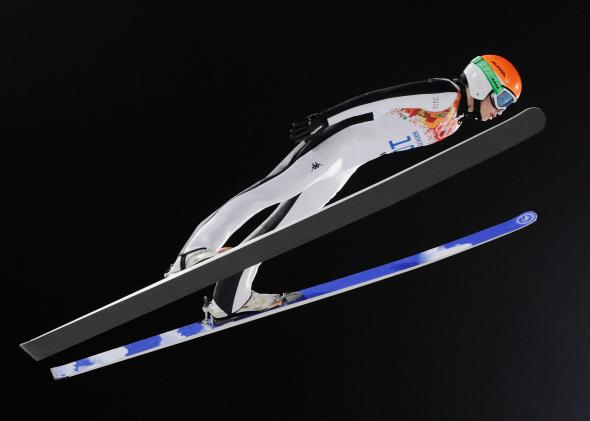On Tuesday, Germany’s Carina Vogt became the first woman to win an Olympic gold medal in ski jumping. Ninety years after men jumped at the inaugural Winter Games in Chamonix—and five years after female jumpers unsuccessfully sued the Vancouver Organizing Committee for the right to join them—women were finally allowed to jump from the same hill that men do. Except that the men are also allowed to jump from a bigger hill. And then teams of four men can all jump off the big hill together. Women still aren’t allowed to do that stuff.
Now that ski jumping has gone (partially) co-ed, only one winter Olympic sport still completely bars women from competition. (That’s the Nordic Combined, which incorporates both a ski jump and a 10 kilometer cross-country race.) But across Sochi, women are still skiing shorter distances, launching from more diminutive hills, and competing on teams of smaller sizes. In cross-country skiing, men can race up to 50 km, but the female courses top out at 30 km. The women’s long-track speedskating event is 5,000 meters, half that of the men’s race. Distances in the women’s biathlon are similarly stunted. Though female bobsledders made their Olympic debut in 2002, they’re still limited to a two-person contest, while male bobsledders compete in a four-man race as well. And while women have been luging in the Olympics since 1964, there’s still no doubles event to match the men’s.
Why are the Olympics half-assing their women’s sports? The abbreviation of women’s competition is a testament to the lingering belief that female bodies are physically incapable of going as long, hard, or high as male ones. When the modern Olympic games kicked off in the 19th century, women were barred from competition completely, and pseudoscience stepped in to justify the choice. “There was this 19th-century idea that women have a limited capacity of what they called ‘vital energy,’ ” says Dr. Amy Bass, a professor of history at The College of New Rochelle who also headed up NBC’s research team during the London Games. Some international athletic leaders continue to perpetuate that view: In 2005, International Ski Federation president Gian-Franco Kasper said that ski jumping “seems not to be appropriate for ladies from a medical point of view.” Just last week, Russian men’s coach Alexander Arefyev argued that jumping requires “too much hard labor” for a woman’s body.
Guys like Arefyev don’t represent the majority viewpoint on female athletes. Exceptional women have successfully plowed through the pseudoscience by repeatedly proving themselves on the slopes. But high-level international sports competitions evolve more slowly than does public opinion.
The International Olympic Committee “is a very elitist and very male organization,” Bass says. Whenever a new event—and a female one in particular—comes up for consideration, “they always worry that including it will lead to a ‘dilution’ of the sport,” Bass says—meaning that women who seem less than truly world-class will be cleared to take the Olympic stage. To receive Olympic recognition, a sport needs to satisfy the IOC’s demand for a history of world championships, a certain number of international federations, and a sizable pool of elite athletes around the world—and not just in countries that fund their female athletes particularly well, or provide institutional support for female athletics in the form of legislation like Title IX. It’s no coincidence that two of the sports that took the longest to let women in—bobsledding and ski jumping—are also two of the most expensive. When it comes to Olympic competition, “women are still playing catch-up in many ways,” Bass says. The IOC may be able to vote in and debut a new sport in the space of four years, but it often comes after “a long, brutal fight” on behalf of the female athletes.
Once a women’s sport clears all of the IOC’s hurdles for inclusion, it is often integrated into the games in a limited capacity and then slowly expands to match the men’s event. The women’s version of the sport traditionally starts at a smaller scale: a smaller hill, a smaller bobsled, a shorter cross-country race. That’s partly due to the lingering effects of those old pseudoscientific beliefs, and partly a practical choice based on where female athletes in emerging sports around the world are most likely to be concentrating their talents. But it’s also a bid to protect the status of the Olympics by boxing some athletes out. As Bass puts it: “The IOC is worried that the Olympics will lose its elite association if they launch too many events as once.” Clearing women to jump from the smaller hill seems like a safer bet than the bigger one; individual sports require a smaller elite talent pool than do team sports.
In 2014, many women’s Olympics sports are still stuck in that protracted transitional period between basic entry and complete participation. It took 78 years for women to be cleared to head down the bobsled track two at a time; 12 years later, the sport hasn’t established itself well enough in the IOC’s eyes to justify a four-woman sled. Of course, the IOC could do a lot to increase the ranks of female endurance athletes and team competitors if it threw its own weight behind their sports. It’s a lot easier to find female athletes who can compete at the Olympic level if the Olympic level actually exists.
